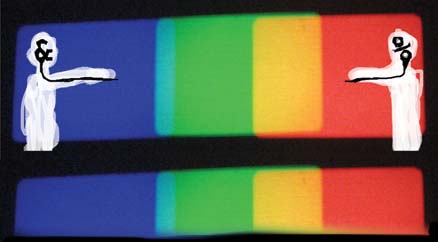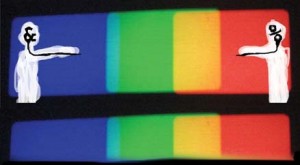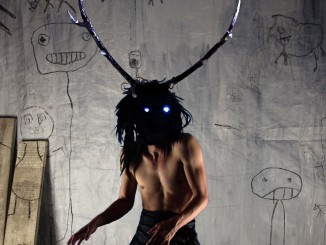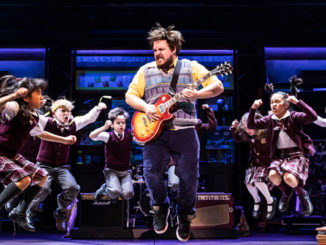
An astounding Journey into the unknown [by James Wenley]

The Civic Main stage is dark, waiting for its first performance of the year. But the building is alive. The show is Bathing with Elephants and other exotic reveries, with much for the inteprid audience member to encounter.
Bathing with Elephants is a collaboration between Vitamin S, Co-Lab and STAMP at THE EDGE. Going in, I could rely only on the beguiling press material describing it as a “cross-bred exotic performance… mixing genre and technology like a kitchen-whizz in a Bombay spice shop”. The project moves through the smaller spaces within the Civic complex – like the Taj Mahal, Safari, and Wintergarden rooms – using the spaces as inspiration for a series of constantly surprising work that belies easy categorisation. We’re taken on a wholly unique, and bizarre, tour of the Civic.
Your destiny is sealed as you choose which way to enter to the foyer. I go past an elegantly bejeweled woman wearing Peacock feathers in her hair (Nisha Madhan), who takes my hand and draws a symbol (two half circles) on my arm with red lipstick. Those using the other entrance get a black triangle from a man wearing a mask. Once all the audience are in, the two silent tour guides arrive and indicate using bells and eye gestures we are to follow . Thus the audience is split into groups based on our markings, and our journey into the unknown begins.
Our guide leads us up a staircase to the next level; she lingers at a large effigy of Buddha. She bows, and then indicates for us to bow too, which we immediately do – she has us.
Throughout the show I notice my levels of awareness and perception growing wider. Here I really discern the ornate decorations of the Civic foyers. Normally when going to shows these areas are full of people, and I’m rushing to my seat. I’m able to take in and appreciate my surroundings, and am especially astounded about the number of elephants that make up the decorations – in the walls, columns and light fittings – they’re everywhere!
Our first encounters with the ‘unexpected’ are tantalisingly brief – as I walk down a corridor I almost miss the strange sight of a man slowly turning, his head a column growing into the ceiling. Our guide gestures us to pause, as a wailing opera singer emerges from the darkness with a lament about her lost love. Before she’s finished, we are willed on by the guide.
In the Safari room we enter to cacophony of noise from female voices. We are invited to open miniature red curtains, peeping into a “backstage” room to seee a group of scantily attired Vaudeville girls from the Civic’s past. They gossip and preen, one asks: “Does anyone have any more mandarins?”. It is a curious feeling watching them ‘unobserved’, as if intruding into their private sphere. It’s no different to the rules of a 4th wall play, but somehow putting up the literal wall in front changes the dynamic. Soon however, its show time, and the normal audience/performer relationship is re-observed as they enter and perform an energetic song and dance number.
This section, ‘The Girls’ (by Genevieve McClean) received a hearty clap. Our attention is next drawn to a series of distorted vaguely elephant-looking figures. Ever changing colours and patterns are projected onto their bodies, accompanied by fuzzy sound. I watch the images transfixed, searching for a meaning I can find in the work. It’s only later that I notice the technician operating the performance, partly obscured by a column. He has microphones and a camera set-up, and makes doodles on a paper that provides some of the live sight and sound. I’m now fascinated by him. This work, ‘Untitled’ by Kim Newall, doesn’t receive a clap, but as much work as ‘The Girls’ has gone into it. What are rules of performance for an audience?
Two musicians next bring to life an elephant skeleton on the other side of the room (‘Wili Pai Sa Sunge (Something little that is of work)’ ) One strums the back, where a harp is built into it. The other explores the potential of the rest of the instrument, as if discovering for himself what sound an elephant skeleton might make. He plays keys along its spine, bangs its rib bones, and blows its trunk. It’s an impressive work of craftsmanship (this blog detailing its creation), and an equally impressive and evocative music experience. This one receives a clap.
Down another dark corridor and we are into the Taj Mahal room. The audience/performance divide is more clearly established here with audience seating facing a stage. Previously the encounters and transitions have been fairly seamless, appearing and disappearing from the ether, but here we wait – the text of the 3M Projector loading on the back wall; the ‘illusion’ and ‘mood’ broken for a time. In ‘Buffalaxed’ by Bronwyn Bent, singer Dharmesh Parikh addresses us telling he is going to make a music video. He will sing a sad song about heartbreak (an interesting echo of the Opera lament), an audience member is invited to translate the lyrics of the song live, which is then projected on the wall behind him. Parikh is an engaging singer, dancing around the stage in a surprisingly upbeat way considering his framing. The translation device is less successful, the set-up meaning that for much of the audience the inputted text is obscured by Parikh moving in front of the projector. Deflecting focus from Parikh, the more interesting task might have been translating the Hindi and song’s meaning for our own selves, without technological intervention.
A fascinating duet and juxtaposition (‘Jungle Book’ by Andrew McMillan with Kristian Larsen and John Bell) between a traditional glockenspiel-like instrument and a tea cup set, follows. As one furiously plays on the glockenspiel, another makes himself tea, discovering the different noises and voices that escape when lifting cups or taking off lids (each are connected to a wire). It’s captivating, and very droll.
Reflections by Tsubasa Kawamoto sees a kaleidoscope of moving lines projected on a screen, accompanied by eerie electronic music. Suited Kawamoto stands alongside the screen, turning knobs on a small tech desk. I’m less engaged by this work, unable to ascertain the relationship to what Kawamoto is doing to what we are seeing and hearing.
Down stairs, and we pass a strange dance (‘Taboo Boob’ by John Bell and Nigel Gavin) in a pit between an Alien and Michael Jackson. Asking ‘why?’ becomes less important than asking ‘why not?’.
The last two substantial sections occur within the Wintergarden, the elegant room below the Civic that usually plays host to the swanky opening night parties. We enter, disorientated, into mist and almost total darkness, the two groups back together. We slowly discern small lights and shapes, and we watch a deep sea encounter between a Whale and a Giant Squid (‘Leviathing’ by Geoff Gilson with Flavio Villani). Lights fade up revealing a Piano and a paddling pool with a poll sticking out of it. The Whale sits down to play (of course), which the Squid dances around and on the poll.
Closing the night is ‘Our Grandfather was the Jaguar’ by Parasytic Fantasy Band (Sam Hamilton). Lights up, and we see rows of chairs on the far side of the room. Other performers from the evening have joined us, the vaudeville girls gossiping in the corner. The friendly host starts a low key chat with the audience, explaining how he is going to call forth a ghost (The Civic’s own famous theatre ghost?). A face emerges from a hole in a small screen in the middle of the room – a man wearing a white sheet with mouth and eyes cut out. The host talks about the nature of ghosts – being without place, and asks the ghost to talk about it. The Ghost reads a report, from text hanging in front of him, about deforestation and newly found forests in El Salvador. Meanwhile, the host projects indistinct slides of a woman on the screen, and begins to paint it white. Using a row of three film projectors, he projects solid colour (yellow, blue and red) onto the screen. As holes are cut into the screen, patterns emerge on the far back wall. A pulsing light, moving film images of the ghost, and pounding music are added.
It’s a well paced and affecting work, each little element and addition combining for a climactic end. On the one hand it used the most basic of Ghostly signs – a man wearing a white cloth, but on the other the build up of sound, colour and imagery makes for an incredible sensual, perhaps even spiritual awakening. It’s creates a strange wash of a feeling – exhausted, overwhelmed, changed – that lingers long after the journey’s end.
Individually it’s difficult to make normal sense of some of the works, but as whole certain key concerns emerge. What are the rules of a performance and how can they is changed? How does one thing relate to another? Overall, we see the exploration of place (in time, and physically), sound and colour and the interplay between them. It’s an invigorating journey of unexpected discoveries.
Bathing with Elephants is only on for two more nights (and on track for a total sell out). This exclusivity gives it something of a rare and fleeting treat, only a chosen few being allowed to experience a different side to the Civic interior. Each will have had their own unique experience, based not only on the group they join and order of work, but where they are in the line, and their different layers of awareness. I hope that Elephant’s three performances will not be its end, continuing in some form so a greater audience can share and wonder.
Bathing with Elephants and other exotic reveries plays at The Civic until Sat 28th January. More information at THE EDGE.
SEE ALSO: Theatreview review by Alexa Wilson




Leave a Reply